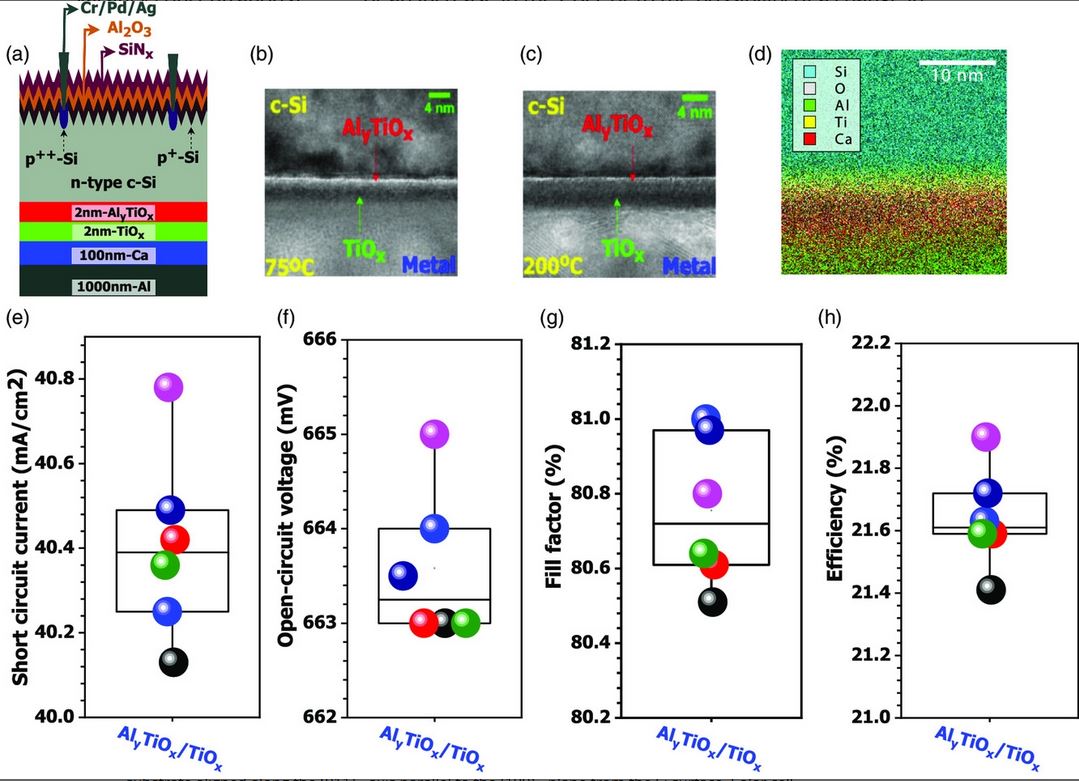Researchers at the Australian National University (ANU) have demonstrated an n-type crystalline silicon solar cell with electron-selective passivating contacts (ESPCs) based on transition metal oxides (TMOs). It reportedly has outstanding surface passivation properties and offers similar electrical performance to passivating contacts based on doped hydrogenated amorphous silicon (a-Si:H) or polycrystalline silicon (poly-Si).
“The limited optical transparency of a-Si:H or poly-Si results in significant parasitic absorption, which limits performance when these contacts are applied to the illuminated side of a cell,” the researchers explained, noting that TMOs are versatile when used as electron- or hole-selective heterocontacts. “Furthermore, these films can be deposited at low temperatures (T ≤ 200 C), implying a strong opportunity for process simplification and cost reduction.”
They designed the carrier-selective passivating contacts with a 2 nm stack based on aluminum-alloyed titanium oxide (Al-TiO2) and a 2 nm stack based on pure TiO2. They said the optimized stack allows superior surface passivation, while maintaining low contact resistivity between the semiconductor material and metal electrode.
“Surface passivation was observed to improve somewhat with rising substrate temperature deposition up to 75 C, before slowly deteriorating above 75 C, reaching its lowest level at 200 C,” they said.
The research team used the novel passivating contacts to demonstrate an n-type c-Si solar cell that achieved a power conversion efficiency of 21.9%, an open-circuit voltage of 665 mV, a short-circuit current of 40.78 mA cm−2, and a fill factor of 80.8%.
“The only moderately high open-circuit voltage of the Al y TiO x /TiO x cells is inconsistent with what would be expected based on the superb surface passivation demonstrated by the novel stack in this study,” they said. “This suggests that surface passivation deteriorates somewhat following metallization.”
The academics said that more work should be done on how to sustain the surface passivation quality after the metallization step. However, they claimed that the initial results are highly encouraging.
“We believe that by definitively addressing these challenges, our novel stack has the potential to match, and possibly outperform, Si-based contacts (a-Si:H and poly-Si) in terms of fabrication cost, simplicity, and performance,” they said.
They described the new approach in “Outstanding Surface Passivation for Highly Efficient Silicon Solar Cells Enabled by Innovative AlyTiOx/TiOx Electron-Selective Contact Stack,” which was recently published in RRL Solar.
“This study establishes a pathway for the development of novel heterocontacts combining outstanding electrical properties with high optical transparency, capable of addressing current performance limitations in high-efficiency c-Si solar cells, based on Earth-abundant, economical, and simple-to-prepare TMOs that are appropriate for industrial use,” they said.
This content is protected by copyright and may not be reused. If you want to cooperate with us and would like to reuse some of our content, please contact: editors@pv-magazine.com.




By submitting this form you agree to pv magazine using your data for the purposes of publishing your comment.
Your personal data will only be disclosed or otherwise transmitted to third parties for the purposes of spam filtering or if this is necessary for technical maintenance of the website. Any other transfer to third parties will not take place unless this is justified on the basis of applicable data protection regulations or if pv magazine is legally obliged to do so.
You may revoke this consent at any time with effect for the future, in which case your personal data will be deleted immediately. Otherwise, your data will be deleted if pv magazine has processed your request or the purpose of data storage is fulfilled.
Further information on data privacy can be found in our Data Protection Policy.